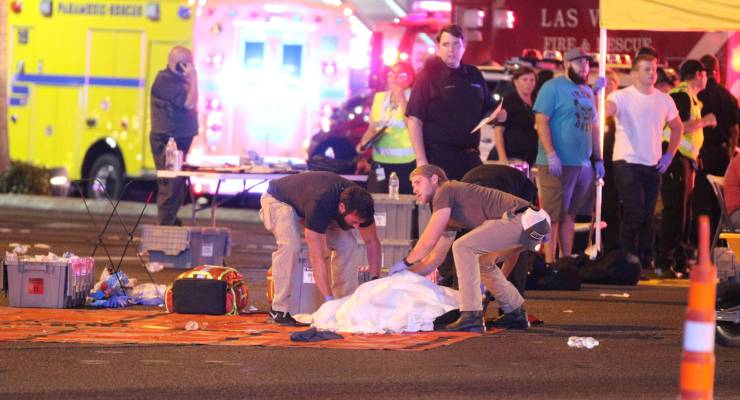
We knew we’d need this one again. In the US, the unthinkable — the wanton slaughter of innocent people, often children — is so commonplace, so mundane. The events in Florida this week (the eighth school shooting in American this year) are only particularly newsworthy for higher than average numbers. Already, the killer has been named, and a monstrous backstory constructed. The following piece, originally published during the aftermath of the Las Vegas massacre in October last year, looks at the grotesque consequences of such reporting.
“A man who was known by no one, is now known by everyone. His face splashed across every screen, his name across the lips of every person on the planet, all in the course of one day.”
That’s from the blog of a 16-year-old who shot dead eight of his classmates and an associate professor at Umpqua Community College in Oregon on October 1, 2015. He’s speaking approvingly of Vester Flanagan, who had received reams of media coverage after shooting Virginian journalist Alison Parker and cameraman Adam Ward (and wounding their interviewee Vicki Gardner) roughly two months earlier. A particular focus of the coverage was Flanagan’s “suicide note” expressing his many personal and professional frustrations and praising the perpetrators of the massacres at Virginia Tech and Columbine.
As the numbing footage and shattering numbers — those dead and injured — in Las Vegas emanated from our televisions and front pages on Monday afternoon, the familiar question cropped up: how can we stop this ever happening again? Debating the answer has unsurprisingly centered on the thorny issue of US gun control. Less commented on has been what role the media plays in all this.
Coverage of the massacre has (as it always does) raked over every element of the shooter’s life, delving into his family, his relationship, the “meticulous” planning of the event, anything that might give a clue as to why this happened. But where does this stop being legitimate reporting and become celebrification of mass murders?
Killing for fame
One of Australia’s preeminent forensic psychiatrists, Emeritus Professor Paul Mullen, who interviewed the perpetrators of the Port Arthur and Hoddle Street massacres (in our conversation, he makes a point of using neither of their names), and also worked on the Snowtown murders, told Crikey only one in 10 mass shooters has a serious mental health issue.
“So the question goes to motivation — why do they do it?” he said. “We know they do it to die. Mass shooters invariably intend to die among their victims — they do it for revenge on a world that has neglected them, and to gain fame.”
Mullen said fame, as a driver, could be identified as far back as the first recorded mass shooting in a Western country in Germany, 1913. The perpetrator stopped at the house of the professor of literature at Stuttgart, dropped off the manuscripts for his plays and books and poetry (all routinely rejected by publishers) and told him “cherish these, for tomorrow I shall be the most famous man in Europe”. He promptly shot 20 people in the village of Muehlhausen.
An open letter from October 3, co-signed by 147 academics, law enforcement officials, public health experts and others begged US media outlets to deny infamy to mass shooters:
“We strongly urge you to take a principled stand in your future coverage of mass killers that could potentially save lives:
1. Don’t name the perpetrator.
2. Don’t use photos or likenesses of the perpetrator.
3. Stop using the names, photos, or likenesses of past perpetrators.
4. Report everything else about these crimes in as much detail as desired.”
One of those signatories is Curtin University’s Glynn Greensmith, a journalist and lecturer whose PhD examines the news framing, in Tasmania’s The Mercury, of the 1996 coverage of the Dunblane (Scotland) and Port Arthur massacres.
“By laying out all this detail, you’re essentially providing a playbook for potential mass shooters,” he told Crikey. “And by delving into every detail of their past, you’re also telling any loner with an arsenal and a grudge, this is how you get everyone’s attention, this is how you get your every grievance and thought brought to light. We will come and find it.”
“The point the letter makes is — is it valid to ask why this happened? Absolutely. Does a forensic recreation of the crime, and raking over a shooters’ every utterance help with that understanding? Absolutely not.”
On Thursday, The Australian‘s front page was covered in promotional style shots of the various automatic weapons the Las Vegas shooter had strewn across the hotel room where he was found. In pornographic detail, it lists the calibre of ammunition, the mechanics of the weapon, the speed with which it fired, the line of sight.
“In some ways I think reporters have the best of intentions in these cases; they want to illustrate the awful destructive power available to citizens in America, and by implication reinforce that these weapons aren’t wanted here,” Mullen said.
Reporting on suicide
The Oz‘s front-page story also opened with a detailed description of the method by which the Las Vegas shooter took his own life, something that would be beyond the pale in any other context.
“Some of the overseas and Australian media have reported the method of suicide used by the perpetrator of the Las Vegas mass shooting, and we would say the same caution applies that media should avoid detail and undue prominence in their reporting,” Marc Bryant, program manager of Mindframe told Crikey.
“Any reporting of a suicide death, regardless of the context, needs to comply with guidelines about minimising details of the methods used.”
Bryant said Mindframe, who have developed guidelines for reporting on suicide and mental illness, were also concerned that media speculation about the killer’s mental health may lead vulnerable people to not seek help.
Mullen said there were a number of factors that had allowed Australia to avoid any mass shootings since Port Arthur.
“Gun control is definitely one of them, but we’ve also been lucky in that many of the people who complete or attempt these acts in Australia have been taken alive, which distrupts their script,” he said. “It’s about dying in a blaze of glory, and we deny them that if they have to undergo the humiliation of a trial and incarceration.”
Mullen also praised the “mostly sober and sensible” coverage of tragedies like Port Arthur.
“But Australian media doesn’t show the same restraint when reporting on America,” he said. “And this is something we may pay a price for.”
Fairfax and The Australian were approached for comment but did not respond by deadline.
Lifeline: 13 11 14 www.lifeline.org.au
Suicide Call Back Service: 1300 659 467 www.suicidecallbackservice.org.au
Beyondblue: 1300 22 4636 www.beyondblue.org.au








I reckon Crikey is inflaming local angst by reporting on that rag The Australian…..
Couldn’t the same thing be said about the coverage of terrorism?
That by reporting the terrorist act far and wide its effects are more substantial.
Have to agree with you WC, of course it does.
As is true for the coverage of mass shootings it not only encourages it gives tips on the best methods. Facts for homicidal nutters 101. Concerts and sporting events provide a large target mass and get up high so better coverage is given of the target mass. Additionally it is harder for anyone to get at you. See example No. xxxx in Los Vegas.
Not allowing the perpetrator their 15 hours of fame would have to reduce the number of incidents.
However don’t hope for anything from our Pollies, this sort of event allows them to stir up fear and introduce more restrictions on our liberties and way of life, giving even greater protection to themselves and their sponsors.
BTW. This article is very similar to the one on “The Drum” last night.
With you all the way. The celebration of these people who have no apparent motive gives them oxygen and encourages others. Not only are details of “how to commit mass murder” lovingly reported, this also includes various tricks that most people would not think of.
Violence porn, for sure.
Answer, “Yes”, sadly Right now someone in America will be thinking ‘I can beat 59’ and ‘I can go out in a blaze of glory’ and ‘Everyone will remember me THEN’. I don’t want or need to know the SLIGHTEST detail of their personal lives, ‘motivations’, manifestos, spurious ‘mental illnesses’ or whatever. Leave them to anonymity and oblivion and maybe remember more about their victims. Great piece. Thanks
The Mandalay Bay killing spree has provided a feeding frenzy for the media. But why have Oz media outlets allowed it to dominate almost every bulletin since Tuesday morning? Evil acts are being perpetrated on the innocent in countries such as Syria, Myanmar etc but, instead, our focus is on a gun porn event.
Meantime, who is putting the blow torch to the Qld & federal governments re the scandalous Adani scam? It has been bypassed as topical news for yet another in the series of relentless US shootings.
I would prefer reporting on mass shootings to be minimal.
I agree. Don’t name the shooter and give him minimal airtime. The endless breathless reporting of this atrocity is completely unnecessary. As you point out, it is only one of many atrocities committed worldwide daily. Why, indeed, has the Adani scandal been allowed to fade into the background?